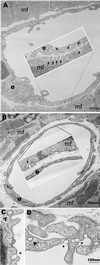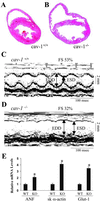Defects in caveolin-1 cause dilated cardiomyopathy and pulmonary hypertension in knockout mice
- PMID: 12177436
- PMCID: PMC123264
- DOI: 10.1073/pnas.172360799
Defects in caveolin-1 cause dilated cardiomyopathy and pulmonary hypertension in knockout mice
Abstract
Caveolins are important components of caveolae, which have been implicated in vesicular trafficking and signal transduction. To investigate the in vivo significance of Caveolins in mammals, we generated mice deficient in the caveolin-1 (cav-1) gene and have shown that, in the absence of Cav-1, no caveolae structures were observed in several nonmuscle cell types. Although cav-1(-/-) mice are viable, histological examination and echocardiography identified a spectrum of characteristics of dilated cardiomyopathy in the left ventricular chamber of the cav-1-deficient hearts, including an enlarged ventricular chamber diameter, thin posterior wall, and decreased contractility. These animals also have marked right ventricular hypertrophy, suggesting a chronic increase in pulmonary artery pressure. Direct measurement of pulmonary artery pressure and histological analysis revealed that the cav-1(-/-) mice exhibit pulmonary hypertension, which may contribute to the right ventricle hypertrophy. In addition, the loss of Cav-1 leads to a dramatic increase in systemic NO levels. Our studies provided in vivo evidence that cav-1 is essential for the control of systemic NO levels and normal cardiopulmonary function.
Figures




References
-
- Palade G. E. (1953) J. Appl. Phys. 24, 1424.
-
- Rothberg K. G., Heuser, J. E., Donzell, W. C., Ying, Y. S., Glenney, J. R. & Anderson, R. G. (1992) Cell 68, 673-682. - PubMed
-
- Palade G. E. (1960) Anat. Rec. 136, 254.
-
- Anderson R. G., Kamen, B. A., Rothberg, K. G. & Lacey, S. W. (1992) Science 255, 410-411. - PubMed
-
- Anderson R. G. (1998) Annu. Rev. Biochem. 67, 199-225. - PubMed
Publication types
MeSH terms
Substances
Grants and funding
LinkOut - more resources
Full Text Sources
Other Literature Sources
Medical
Molecular Biology Databases

